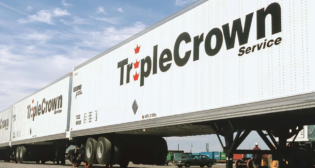
PSR Point/Counterpoint: Fortune
Written by William C. Vantuono, Editor-in-ChiefEditor’s Note: Precision Scheduled Railroading (PSR) continues to be, in a word, controversial. This operating method traces its origins to the late Hunter Harrison and the Illinois Central in the early 1990s. It was subsequently adopted by CN following its acquisition of IC. It then spread to Canadian Pacific when Harrison was installed as CEO in 2012, and then CSX when he arrived there in 2017, shortly before his death. Norfolk Southern, Union Pacific and Kansas City Southern soon after adopted their own versions of PSR. BNSF, which does not directly report to Wall Street, remains the lone holdout. Fortune, founded by Time Magazine co-founder Henry Luce in 1929 as “The Ideal Super-Class Magazine,” recently published two contrasting editorials on PSR.
The first editorial, by Ike Brannon, Senior Fellow at the Jack Kemp Foundation, and Michael F. Gorman, Niehaus Chair in Operations and Analytics at the University of Dayton and Editor-in-Chief of the INFORMS (Institute for Operations Research and the Management Sciences) Journal on Applied Analytics, takes the pro-PSR stance. The response, by House Transportation and Infrastructure Committee Chair Peter DeFazio (D-Ore.), paints PSR as “a business strategy promoted by Wall Street to boost short-term profits.”
Railway Age (founded in. 1856) offers these two contrasting viewpoints to our readers, without editing or editorial comment. Bear in mind that both were written for Fortune’s non-professional-railroader readership. We are willing to publish reasonable, fact-based, non-political opinions on PSR by experienced railroaders from both the agreement and non-agreement sectors, to encourage discussion.
Railroads Are Trying to Boost Productivity. But Unions Are Standing on the Tracks
By IKE BRANNON and MICHAEL F. GORMAN
Fortune, July 9, 2021
When members of Congress express their concern that an industry may not be making the best decisions for its long-term health, those businesses had better start guarding their wallets.
These days it is the private freight railroad industry that finds itself in this predicament. In the past few years, most major railroads have made significant investments to implement something called precision scheduled railroading, or PSR, which holds the potential to increase the amount of goods they can transport on their current tracks, partly by running fewer—but longer—trains. Since fewer trains would mean fewer jobs for railroad workers, their unions are upset. Hence the concern in Congress.
Congressman Peter DeFazio, chair of the House Transportation and Infrastructure Committee and a Democrat, recently announced that his committee would ask the Government Accountability Office (GAO) to study the impact that precision scheduling is having on workers at railroads, customers that ship on railroads, and passenger railroads.
DeFazio says he is concerned that precision scheduling puts the bottom line first, which he says will lead to more train accidents as well as unhappy customers and overworked employees, potentially jeopardizing the long-run health of the railroad industry.
However, none of these objections stand up to the least bit of scrutiny: The real objection is simply that precision scheduling may eliminate some rail jobs over time.
PSR is an effort by railroads to increase the capacity of their lines by operating on a fixed, predictable schedule. One way railroads achieve this is by running longer trains, which increase a railroad’s carrying capacity: Two 100-car trains need less spacing than four 50-car trains, so more cars can be accommodated.
Longer trains also reduce labor costs, since fewer trains means fewer crews are needed. Given that railroads finance their own infrastructure, controlling costs is crucial for the industry to compete against other modes of transportation.
Precision scheduling also imposes fixed schedules on shippers, which makes it easier for railroads to schedule their tracks at or near full capacity. Union labor objects to this change as well, as it allows railroads to reduce overtime.
Train crews cannot work more than 12 hours a day, and a railroad with an unpredictable schedule often needs to stop a train, bring in new engineers and conductors, and put up the workers in a hotel to get their required rest before returning to their job. Staff get paid for the downtime away from home.
A predictable schedule would allow railroads to schedule workers on more out-and-back routes that have them working a full day and ending up back home, reducing these spells away from home—as well as their overtime pay. Although such practices reduce fatigue and improve quality of life, many are loath to lose their away-time pay—belying their insistence that safety is their main concern.
DeFazio asked the GAO to study this very same issue two years ago, and it reported that it did not have the data to do the analysis he wanted. The Federal Railroad Administration has said that the data it has collected does not show that safety has been affected by these changes, and previous studies take issue with the assertion by the engineer unions that more staffing is necessary for longer trains.
And while DeFazio pushes the GAO to find evidence of harm from railroads improving productivity, he ignores the fact that increasing goods shipped by rail can reduce the number of trucks on our highways. This reduces congestion and smog and greenhouse gas emissions and improves highway safety, all of which are ostensible goals of DeFazio and Congress.
The Biden Administration and Congress have other problems with railroads. Earlier this month President Biden announced that it will ask the Surface Transportation Board to address what the Administration perceives as anticompetitive behavior in the industry, most of which it attributes to the rapid pace of consolidation in the past few years that has left numerous shippers with access to only a single rail line.
But it’s a perspective that contradicts the stated concerns of DeFazio and his allies that precision scheduling may jeopardize the future viability of the railroads. Further, it affects the revenue side of the rail equation while DeFazio and his colleagues add costs. These policies in combination are a bigger threat to the rail industry than PSR.
That DeFazio and some of his colleagues on the House Transportation and Infrastructure Committee continue to push for railroads to roll back productivity gains, despite any evidence that those gains compromise safety or railroads’ long-term viability, makes it clear that their real objective is to protect jobs of unions that support the Democratic Party. That they also seem interested in micromanaging profits and wages in the rail industry should sound an alarm for other businesses hoping to invest and improve their productivity.
Wall Street is Boosting Profits in Railroads with New Technology. But It’s Ignoring the Drawbacks
By PETER DEFAZIO
Fortune, July 21, 2021
In a commentary published in Fortune earlier this month, Ike Brannon and Michael F. Gorman took great liberties in trying to debunk my concerns with Precision Scheduled Railroading (PSR). Please allow me to set the record straight.
I have served on the U.S. House Committee on Transportation and Infrastructure for 34 years, crafting public policy through seven different Presidential Administrations, both Democratic and Republican. Freight transportation is critical to our economy. The ability to efficiently, reliably and safely deliver freight makes us more competitive in the global economy.
And many transportation stakeholders agree that freight rail is critical to reducing our nation’s carbon emissions. The transportation sector is now the highest emitter of greenhouse gases in the country and shifting more freight from trucks to rail could significantly reduce these emissions. Freight railroads estimate that if 25% of the truck traffic moving at least 750 miles went by rail instead, annual greenhouse gas emissions would fall by approximately 13.1 million tons.
But PSR is not some fancy optimization strategy to increase freight volume or improve operations and reduce emissions; rather, it is a business strategy promoted by Wall Street to boost short-term profits. Wall Street investors have proven they don’t care about the long-term health of the industries from which they seek to extract wealth. Similarly, they don’t care about ensuring an efficient, reliable, and safe freight service that drives the U.S. economy.
And they’re not hiding it. Investor calls demonstrate that Wall Street investors’ myopic focus on short-term profits demands that railroads boost quarterly profits by cutting costs and increasing revenues. In doing so, great freight rail service and the long-term health of the industry is sacrificed.
At public proceedings before my committee and the Surface Transportation Board (STB), and in public letters, an array of shippers have detailed the effects PSR has had on freight movement. These include disruptive changes to operating plans and service schedules; degradation of service, such as delays due to insufficient locomotive power and lack of crews; and unreasonable charges, such as increases in demurrage and accessorial fees. Some shippers have even been forced to use more trucking as a result.
One of the many impacts of PSR is the uncontrolled growth in train lengths. A U.S. Government Accountability Office (GAO) study found that between 2008 and 2017, train length grew by 25% for two Class I railroads (which comprise the seven largest railroads in the U.S.), and officials from each Class I stated they operate longer trains, including some that extend for several miles. Freight railroad investor calls continue to boast annual train length increases every year.
The Federal Railroad Administration (FRA) is still studying the safety impacts of these long trains. While investors reap the benefits, the general public experiences the drawbacks. What was once a few-minute annoyance now can cause community-wide traffic jams and emergency services delays—concerns expressed to the GAO by the National League of Cities and state and local officials.
And it’s getting worse. In multiple committee hearings, I have heard testimony that these longer trains are more frequently blocking crossings for longer amounts of time. Wall Street may not care, but Main Street does.
And finally, freight rail does not function without a strong workforce. Let’s not forget that prior to COVID-19, from 2015 to 2019, the freight railroad industry slashed the average size of its workforce by more than 17%. It’s little wonder that STB Chairman Martin Oberman has sought information about how such a reduction may be related to or contributed to recent shipper complaints. I may be guilty of caring about middle-class workers and their safety more than Wall Street millionaires and billionaires, but I sleep just fine bearing that burden.
My goal has been and remains to foster a healthy freight rail market that boosts the overall economy and reduces carbon emissions. Wall Street’s goal is to get wealthier—no matter the impact on our economy, environment, transportation system or workforce.



